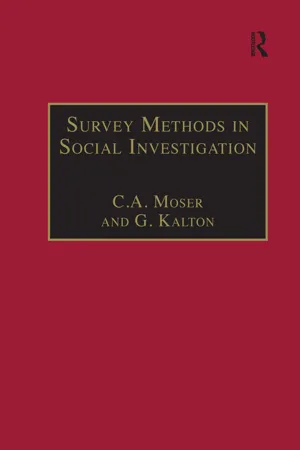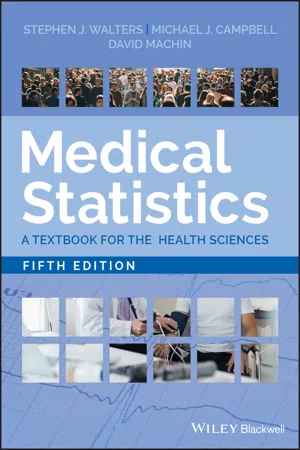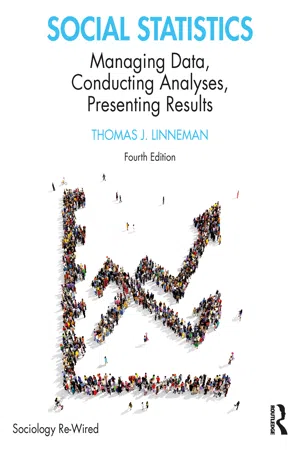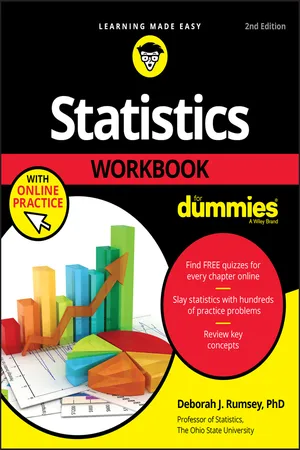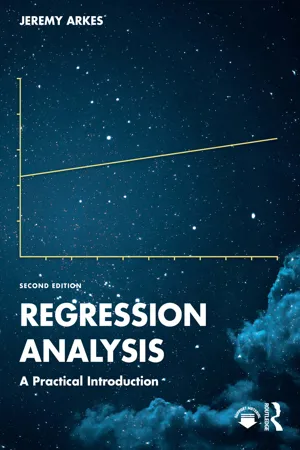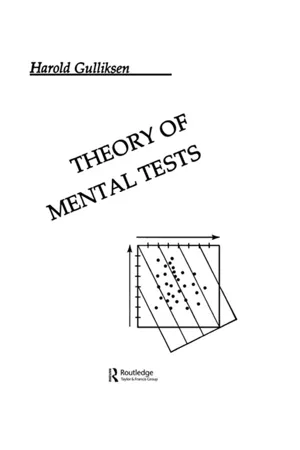Mathematics
Standard Error
The standard error measures the variability of sample means around the true population mean. It quantifies the precision of the sample mean as an estimate of the population mean. A smaller standard error indicates that the sample mean is likely closer to the true population mean, while a larger standard error suggests greater uncertainty in the estimate.
Written by Perlego with AI-assistance
Related key terms
Related key terms
1 of 4
Related key terms
1 of 3
8 Key excerpts on "Standard Error"
- Nicoleta Gaciu(Author)
- 2020(Publication Date)
- SAGE Publications Ltd(Publisher)
To overcome this matter of representativeness, for a researcher, it is essential to consider the Standard Error (SE), which estimates the variation of a sample statistic from the population parameters. For example, the mean will vary from sample to sample, and the Standard Error of the mean describes the standard deviations of a distribution of means for samples of a given size n. The Standard Error is a theoretical concept because the population parameters are unknown, but the Standard Error of the mean can be quantified and expressed as the extent to which a sample mean can vary (the standard deviation of the mean) as a different sample of the same size is randomly selected from the same population (sampling distribution). The Standard Error of the sample mean depends on both the standard deviation of the population (σ) and the sample size (n) by the following relationship: If the sample size increases, the Standard Error decreases, which means that the chance of variation is reduced. Unfortunately, this formula involves the standard deviation of the population, which is unknown in practical situations- eBook - ePub
- C.A. Moser, G. Kalton(Authors)
- 2017(Publication Date)
- Routledge(Publisher)
Column (a) is fairly typical of the sampling distribution of a mean, with a strong peak at the centre and a fair spread on either side. Columns (b) and (c) show other distributions that might have been obtained; in (b) the estimates derived from the samples differ very widely, in (c) they are closely bunched together. It is evident from these that the chance of any one sample estimate being close to μ depends on how widely dispersed all the estimates are, in fact on the spread of the sampling distribution. If this spread is high, as in (b), any one estimate is likely to be a long way out. If, to take the opposite extreme, the estimates are closely bunched around their mean, as in (c), no one estimate is likely to be far from μ.What is here called the precision of a sample estimator thus depends on the spread of the sampling distribution, and this is conveniently measured by its own standard deviation, i.e. by the Standard Error. If the sample statistic in question is the mean, then the relevant distribution is the 'sampling distribution of the mean', the relevant Standard Error the 'Standard Error of the mean'; if it is a proportion, the terms are 'sampling distribution of the proportion' and 'Standard Error of the proportion'. We will for the moment continue to keep the discussion to the case of the mean.The formula for the Standard Error of the mean was given on p. 66; leaving aside the f.p.c., we note that it is based on the two factors on which one would expect the precision of a sample estimator lo depend:(a) the value of n , i.e. sample size. Common sense suggests that one will get more precise results from a large than from a small sample; formula (4.1) shows that the Standard Error varies inversely to the square root of n —that is, to halve the Standard Error requires (other things being equal) four times as big a sample.(b) the value of S (or σ), i.e. variability in the population. This also accords with common sense. If the 3,000 students are all aged exactly 23, any sample will estimate the population mean with complete precision. The population standard deviation, S or σ, would be zero, and so, from formula (4.1), would the Standard Error. If, on the other hand, the ages of the 3,000 vary over a wide range, the estimation of the population mean from one sample is much more 'chancy'; this will be reflected in a widely spread sampling distribution (say like (b) in Table 4.1 - eBook - ePub
Medical Statistics
A Textbook for the Health Sciences
- Stephen J. Walters, Michael J. Campbell, David Machin(Authors)
- 2020(Publication Date)
- Wiley-Blackwell(Publisher)
Figure 5.2 clearly shows that the spread or variability of the sample means reduces as the sample size increases. In fact, in turns out that sample means have the following properties.Properties of the Distribution of Sample Means
The mean of all the sample means will be the same as the population mean. The standard deviation of all possible sample means is known as the Standard Error (SE) of the mean or SEM. Given a large enough sample size, the distribution of sample means, will be roughly Normal regardless of the distribution of the variable.The Standard Error or variability of the sampling distribution of the mean is measured by the standard deviation of the estimates. If we know the population standard deviation, σ, then the Standard Error of the mean is given by . In reality, an investigator will only complete a study once (although it may be repeated for confirmatory purposes by others) so this single study provides a single sample mean, , and this is our best (and only) estimate of μ. The same sample also provides s, the standard deviation of the observations, as an estimate of σ. So, with a single study, the investigator can then estimate the standard deviation of the distribution of the means by without having to repeat the study at all.Properties of Standard Errors
The Standard Error is a measure of the precision of a sample estimate. It provides a measure of how far from the true value in the population the sample estimate is likely to be. All Standard Errors have the following interpretation:- A large Standard Error indicates that the estimate is imprecise.
- A small Standard Error indicates that the estimate is precise.
- The Standard Error is reduced, that is, we obtain a more precise estimate, if the size of the sample is increased.
Worked Example – Standard Error of a Mean – Birthweight of Preterm Infants
Simpson (2004 ) reported the birthweights of 98 infants who were born prematurely, for which n = 98, = 1.31 kg, s = 0.42 kg and the SEM often written SE( - eBook - ePub
Social Statistics
Managing Data, Conducting Analyses, Presenting Results
- Thomas J. Linneman(Author)
- 2021(Publication Date)
- Routledge(Publisher)
A sampling distribution has its own special version of the standard deviation: the Standard Error. I took 300 samples. Many of them were very close to the population mean (meaning that they had little sampling error: they very nicely represented the population mean). Some were far away from the population mean (meaning that they had quite a bit of sampling error: they did not provide very good estimates of the population mean). We can calculate the average distance that these sample means are from the population mean, the average error, or what we call the Standard Error. We’ll do this using exactly the same process we used to calculate the standard deviation. First, we need to calculate the distance each value of the sample mean is from the population mean. Next, just as we did when we calculated the standard deviation, we will square these distances. Before we do this, I’m going to switch from words to symbols. For the sample mean, I’ll use what I’ve used before: x ¯. For the population mean, I’m going to use a Greek symbol (we tend to use Greek symbols when we’re talking about populations). That symbol is μ, and it’s pronounced /myoo/ (like a French cow). Note that I’m using the sampling distribution based on the example that started this chapter (the one with the symmetrical population, not the skewed population). Exhibit 5.18 Calculating Distances From the Population Mean Sample Mean Sample Mean – Population Mean 1.8 1.8 – 2.5 = –0.7 1.9 1.9 – 2.5 = –0.6 2.0 2.0 – 2.5 = –0.5 2.1 2.1 – 2.5 = –0.4 2.2 2.2 – 2.5 = –0.3 2.3 2.3 – 2.5 = –0.2 2.4 2.4 – 2.5 = –0.1 2.5 2.5 – 2.5 = 0.0 2.6 2.6 – 2.5 = 0.1 2.7 2.7 – 2.5 = 0.2 2.8 2.8 – 2.5 = 0.3 2.9 2.9 – 2.5 = 0.4 3.0 3.0 – 2.5 = 0.5 3.1 3.1 – 2.5 = 0.6 3.2 3.2 – 2.5 = 0.7 3.3 3.3 – 2.5 = 0.8 Exhibit 5.19 Squaring Distances From the Population Mean μ μ – x̄ (μ – - eBook - ePub
- Stephen Horan(Author)
- 2017(Publication Date)
- CRC Press(Publisher)
Youn62 ]Table 3.2:Sample Data for Computing Mean and Variance(3.28)σ=μ2⟨Nσ 2⟩The error in the mean for the data set in Table 3.2 is 0. 0080. As we see from Equation (3.28) , the number of data points in the measurement set influences the error in the mean. The greater the number of points in the data set, the smaller the error in the mean.Uncertainty in the Mean Just as the standard deviation is the square root of the variance, the uncertainty in the mean is the square root of the error in the mean, or [Rabi95 ; Youn62 ](3.29)σ μ=⟨Nσ 2⟩For the example data set in Table 3.2, the uncertainty in the mean is 0. 0894.Figure 3.12: The distribution of mean values about the “mean of the means.”3.5.3 Measurement UncertaintyAs we saw at the beginning of this chapter, measurement uncertainty is one of the three “pillars of metrology.” While the statistical estimates of the error in the mean and the uncertainty in the mean are quantities that are easy to compute, they do not really tell the user how close they might be to the true value, except in the most general way. The measurement system has other unknowns than just those associated with the measurement instrument itself. Given total environment, the experimenter must consider any measurement as uncertain to some degree. In this section, we will examine ways for the experimenter to express the measurement uncertainty.
We need to think in terms of overall uncertainty because, as the GUM states, the3.5.3.1 Uncertainty Definitionuncertainty of the result of a measurement reflects the lack of exact knowledge of the value of the measurand. The result of a measurement after correction for recognized systematic effects is still only an estimate of the value of the measurand because of the uncertainty arising from random effects and from imperfect correction of the result for systematic effects [GUM08 - Deborah J. Rumsey(Author)
- 2019(Publication Date)
- For Dummies(Publisher)
values handy as you do the problems in this chapter.Textbooks will differ in terms of the exact number of standard deviations to add/subtract for 90 percent confidence. The most accurate answer is exactly between 1.64 and 1.65, which is 1.645. Throughout this workbook, however, I use 1.64. Ask your professor which one he or she prefers.- The standard deviation of the population: The amount of variability that exists in the population in terms of the variable you’re measuring. If the standard deviation isn’t available for the population, you substitute the standard deviation of the sample and use the t -distribution (more in Chapter 11 ).
- The sample size: The total number of values in the data set — denoted n.
The general formula for margin of error (if n is large) is: times the standard deviation divided by the square root of n (where n is the sample size). You generally take your sample statistic (the mean or proportion) and add or subtract the margin of error to get a confidence interval for the population value. (More about generating confidence intervals in Chapter 11 .) See the following for an example of the importance of margin of error.Q. You hear in a dentist’s ad that only 45 percent of adults floss their teeth daily. Explain why these results are virtually meaningless without the margin of error.A. Without a margin of error, you have no way of knowing how precise or consistent these results would be from sample to sample. They can vary so much that the 45 percent becomes unrecognizable, or they can vary so little that the 45 percent is about as close as you can get to the truth.1 Suppose that you want to be 99 percent confident in your results, and you plan on having a large sample size. What’s your value?2- eBook - ePub
Regression Analysis
A Practical Introduction
- Jeremy Arkes(Author)
- 2023(Publication Date)
- Routledge(Publisher)
2 , in the top-right panel, is 0.210 (which is roughly 1.47 ÷ 7.01) In the bottom panel of the table, the variables used in the model are listed.Note that the variables for the highest-grade-completed of the mother were missing for 808 respondents (6.4% of the initial 12,686 respondents), and the variables for the highest-grade-completed of the father was missing for 1806 respondents (14.2%). For the sake of keeping the observations for this exercise, I did the technically-incorrect thing of assigning a value of zero for the mother and father’s educational variables if they were missing. In Section 12.2.7 , I discuss a better option for dealing with missing data.The first number in each row represents the coefficient estimate on the given variable. The second number is the Standard Error of the given coefficient estimate. The Standard Error is a measure of how precise the coefficient estimate is. Often Standard Errors are reported in studies in parentheses next to or under a coefficient estimate.From the Appendix of Background Statistics Tools, an “estimator” is the best guess we have for what the true population estimate is. The coefficient estimate in a regression is an estimator as well. There is inevitably randomness in the estimate due to two major sources: (1) often having just a sample of the population; and (2) the outcome itself being subject to randomness. A Standard Error is the standard deviation of the sampling distribution for the coefficient estimate.In some sense, the coefficient is a random variable in the population. For example, being Hispanic wouldn’t affect income the same for all Hispanics. What would be estimated, if proper controls were included, would be an average association of being Hispanic with income for the selected sample (Section 2.11). If we were to select a different sample, we would likely obtain a different coefficient estimate. - eBook - ePub
- Harold Gulliksen(Author)
- 2013(Publication Date)
- Routledge(Publisher)
IGURE 3. The true Standard deviation, and error of measurement as functions of the test reliability and Standard deviation.Standard deviation. Then note the intersection of this particular radius and circle. The y -coordinate of that point is the true Standard deviation, the x -coordinate of that point is the error of measurement for that test.For example, the point marked with a circle is where the reliability is .64, and the Standard deviation of observed scores is 7. In this case the Standard deviation of the true scores is 5.6 , and the error of measurement is the x -coordinate of the same point, 4.2 .If we know the true and error Standard deviations, it is possible to use the same diagram to read off the reliability and the observed Standard deviation. In this case, look up the true Standard deviation on the y -axis, the error of measurement on the x -axis, find the point with these two Coordinates, and then read the value of the radius through this point to find the test reliability, and the value of the circle through this point to find the Standard deviation of observed scores.In general we may describe this graph by pointing out that it is a combination of rectangular and polar coordinate systems. Any point in it represents four quantities, one on the x -axis, one on the y -axis (the rectangular coordinate system), one on the radius, and one on the circle (the polar coordinate system). Each point, which represents four quantities, is determined by any two of these quantities. Therefore, generalizing, we may say that given any two of the four quantities involved, it is possible to determine the other two.11. Use of the error of measurement
It should be noted that, in the development of the equations of this chapter, there is no reference to any particular type of frequency distribution. It is assumed that the average error is zero, and that errors are uncorrelated with each other or with true score. All the equations of this chapter follow from these assumptions, regardless of the frequency distribution of true scores, error scores, or observed scores. However, it is not possible to make use of the error of measurement without some assumption about its distribution. This quantity is usually assumed to be normally distributed. Figure 4 gives a concrete illustration for a particular test in which the error of measurement is assumed to be 5 score points. Observed scores are indicated on the base line. A
Index pages curate the most relevant extracts from our library of academic textbooks. They’ve been created using an in-house natural language model (NLM), each adding context and meaning to key research topics.
Explore more topic indexes
Explore more topic indexes
1 of 6
Explore more topic indexes
1 of 4

